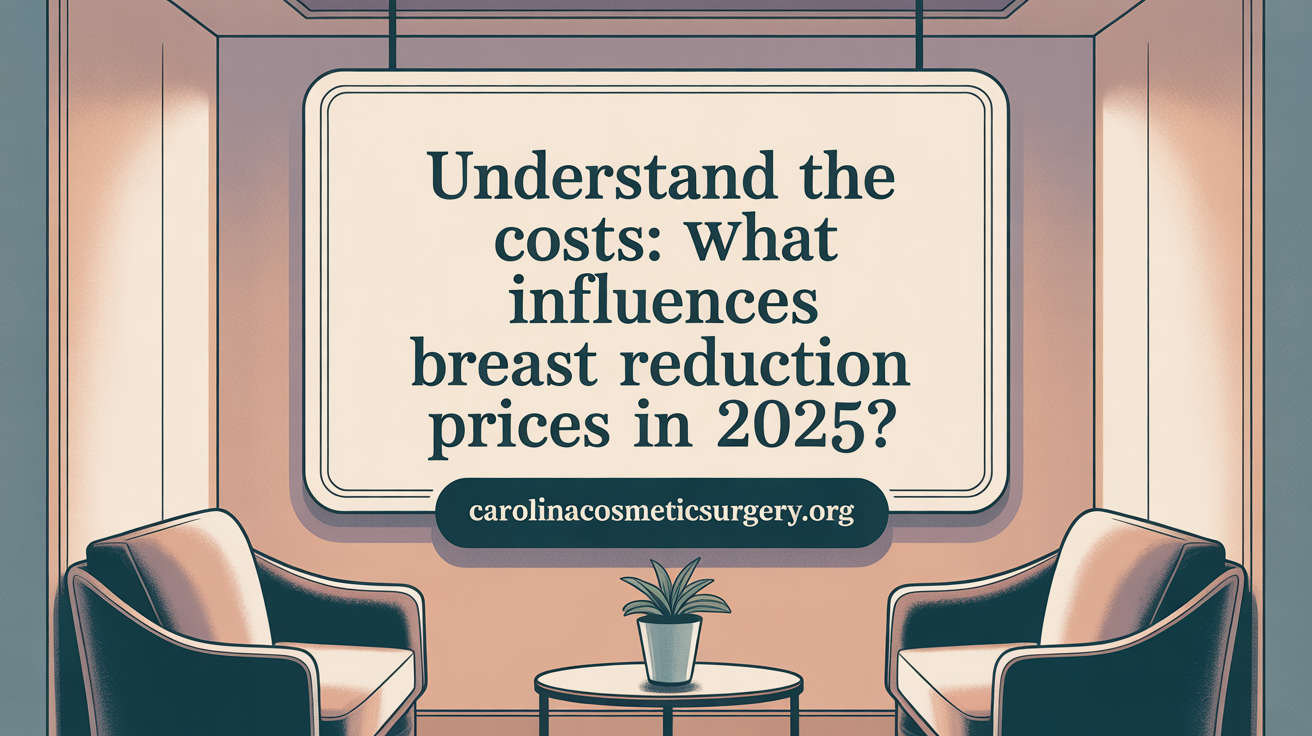Understanding the Changing Landscape of Breast Reduction
Breast reduction surgery has been gaining significant attention over the past few years, evolving in response to shifting patient needs, technological advancements, and changing beauty standards. As we approach 2025, it is essential to explore the current trends, demographic insights, cost structures, and patient motivations that are shaping this procedure’s popularity and success. This article delves into the latest data, forecasts, and innovations influencing breast reduction surgery, offering a comprehensive outlook on what patients and practitioners can expect in the near future.
Popularity and Demographic Trends in Breast Reduction Surgery

Is breast reduction becoming more popular?
Recent data confirms that breast reduction procedures are experiencing increased popularity. The American Society of Plastic Surgeons reports a significant rise, with the number of surgeries growing. In particular, there’s a noticeable trend among younger women, including those under 30, who are increasingly opting for this surgery.
Each year, over 70,000 women undergo breast reduction in the United States alone. This growth reflects a broader acceptance of the procedure and an increasing recognition of its physical and emotional benefits. Women are seeking relief from discomfort such as back pain, neck strain, and sagging, while also aiming to improve their self-confidence and aesthetic appearance.
Demographic shifts, including younger patients
Younger patients are now more frequently choosing breast reduction surgery. Traditionally popular among middle-aged women, the trend shows that even younger demographics are motivated by both health reasons and societal influences.
This shift is partly driven by increased awareness through social media and celebrity testimonials, which highlight the positive impacts of the procedure. Many younger women view breast reduction as an option not only for health but also for aligning their body image with their personal style.
Social and cultural influences on popularity
Social media platforms and celebrity culture have had a strong influence on the rising interest in breast reduction. Influencers and public figures openly discuss how the procedure has improved their quality of life, helping destigmatize it.
Moreover, changing beauty standards favor more natural and proportionate body shapes. The 'ballerina body' aesthetic—sleek and balanced—aligns with the goals of many women seeking a more proportionate figure, which breast reduction can help achieve.
Patient satisfaction and motivations
Patients widely report high satisfaction rates, approximately 97%, after their breast reduction surgeries. The primary motivations include relieving physical discomfort and enhancing self-confidence.
Many women express immediate physical and emotional relief post-surgery, with some wishing they had undergone the procedure sooner. The benefits extend beyond aesthetics, contributing significantly to improved posture, ease of physical activity, and overall well-being.
As the popularity of breast reduction continues to grow, it is increasingly seen as a vital option for women seeking healthier, more comfortable, and confident lives. The trend underscores a societal shift toward valuing health and natural beauty, driven by advances in surgical techniques and more open conversations about body image.
Current and Projected Trends in Breast Reduction for 2025

What are the current and projected trends in breast reduction procedures for 2025?
The landscape of breast reduction surgery is evolving rapidly, with several notable trends shaping the approach and expectations for 2025. Today, there is a clear shift towards achieving natural, proportionate aesthetics that harmonize with overall body goals. Patients increasingly favor smaller, more subtle modifications that enhance their natural shape without overpowering their figures.
In addition to aesthetic preferences, health benefits such as alleviation of back, neck, and shoulder pain, as well as improved posture, continue to drive the demand for surgical intervention. This dual focus on beauty and wellness makes breast reduction a highly appealing choice for many.
Surgical techniques are becoming more refined and less invasive. Minimally invasive procedures, including liposuction-only reductions and advanced imaging technologies like 3D surgical planning, allow for precise, personalized results with minimal scarring and quicker recovery times. These innovations help surgeons tailor procedures more effectively to individual anatomy.
Furthermore, implant technology has advanced significantly. Natural-feel, cohesive silicone gel implants—sometimes shaped as teardrops—support more natural-looking outcomes. Many patients now prefer implants in smaller sizes, such as 250–300cc, to emphasize proportion rather than size, aligning with the trend toward subtle enhancement.
Younger patients are increasingly seeking breast reduction for both health and aesthetic reasons. They are often influenced by societal shifts promoting body positivity, with a focus on holistic wellness.
The overall trend in 2025 points toward less invasive, highly personalized surgeries that prioritize natural results, improved comfort, and mental health benefits. Combining surgical innovation with a growing emphasis on natural beauty and wellness, breast reduction continues to evolve as a key procedure in aesthetic and reconstructive plastic surgery.
| Trend Aspect | Description | Impact |
|---|---|---|
| Natural and proportionate aesthetics | Focus on subtle, balanced breast shapes | Meets patient demand for natural look, supports holistic beauty standards |
| Minimally invasive techniques | Use of liposuction, advanced imaging | Reduces scarring, shortens recovery, enhances precision |
| Younger patient demographics | Increasing procedures among younger adults | Expanding the market, emphasizing health benefits and social influences |
| Health benefits | Pain relief, improved posture | Adds functional value to aesthetic treatments |
| Surgically innovative solutions | Advanced implants, personalized planning | Achieves better, tailored results with minimal downtime |
These trends demonstrate a thoughtful shift toward procedures that prioritize natural appearance, health, and patient-centered care.
Cost Analysis and Influencing Factors of Breast Reduction Surgery in 2025

What are the average costs and cost ranges for breast reduction in 2025?
In 2025, the average cost of breast reduction surgery for aesthetic patients is approximately $6,771. However, the total expense can vary widely depending on several factors. On the lower end, procedures may cost as little as $2,900, while more complex surgeries could reach up to $20,000. The wide range reflects differences in geographic location, surgeon expertise, surgical techniques, and facility choices.
Which factors influence the cost of breast reduction surgery in 2025?
The price of breast reduction surgery in 2025 is shaped by multiple elements. Geographic location is a primary driver, with costs differing significantly across states and regions. Surgeons with extensive experience, specialized training, or high demand generally charge higher fees. The complexity of the procedure also affects the price; additional procedures like a lift or fat transfer can add to the total.
Other cost-influencing factors include anesthesia fees, facility charges, pre- and post-operative medical tests, prescriptions, and supportive garments. These components all contribute to the overall expenditure. Insurance coverage may mitigate some costs, especially if the surgery is medically necessary, although documentation requirements and copays can still impact out-of-pocket expenses.
Can you provide a breakdown of the typical cost components?
The total cost of breast reduction surgery includes multiple elements:
- Surgeon’s fee: The primary cost, varying with experience and location.
- Facility fee: Use of surgical space in hospitals or clinics.
- Anesthesia: Anesthesiologist’s charges depend on the anesthesia method used.
- Pre-operative testing: Blood tests, imaging, and consultations.
- Post-operative care: Follow-up visits, medications, and support garments.
- Additional procedures: If combined with other surgeries, such as a breast lift, costs increase.
The average breakdown might look like this:
| Cost Component | Typical Range | Notes |
|---|---|---|
| Surgeon’s fee | $2,768 - $19,000 | Higher for specialists or complex cases |
| Facility fee | $1,000 - $3,000 | Depends on hospital or clinic |
| Anesthesia | $600 - $1,500 | Varies based on anesthesia type |
| Pre-op testing | $200 - $1,000 | Includes labs and imaging |
| Post-op care | $200 - $2,000 | Medications, garments, follow-ups |
What are the insurance coverage and financing options available?
Insurance may cover breast reduction if the procedure is deemed medically necessary, typically for relief from physical symptoms such as pain or discomfort. Proper documentation of medical issues is essential for approval. Coverage varies by insurer and region, with some covering the full or partial cost.
For those paying out of pocket, financing options are widely available. Many clinics partner with third-party financing providers like Credee, which offers flexible payment plans with no credit check and high approval rates. These programs make it easier for patients to afford surgery without a large upfront payment.
Understanding all these factors helps prospective patients prepare financially and choose the appropriate surgical approach and provider for their needs.
Technological Advancements and Surgical Techniques Shaping Breast Reduction in 2025

What technological advancements and surgical techniques are emerging in breast reduction for 2025?
In 2025, breast reduction surgery is set to benefit from a variety of innovative technological advancements and refined surgical techniques. A major development is the rise of minimally invasive procedures, especially liposuction-only techniques. These procedures involve smaller incisions, resulting in less scarring and a quicker recovery process for patients.
Advanced imaging technologies play a crucial role in personalized surgical planning. 3D imaging and printing allow surgeons to create detailed models of each patient’s anatomy, helping to tailor the procedure precisely to individual needs. This technology enhances surgical accuracy and helps patients visualize potential outcomes, leading to higher satisfaction.
Robotic-assisted surgical systems are also gaining traction. These systems enable highly precise movements, allowing for less invasive surgeries with minimal tissue disturbance. The use of robots contributes to better contouring and reduces risks associated with traditional open techniques.
Improved anesthesia methods are improving patient safety and comfort during and after surgery. Innovations include options that reduce anesthesia-related side effects and promote faster recovery.
Enhanced visualization tools, like liquid perception technology and high-definition video assistance, are helping surgeons see detailed structures within the breast tissue more clearly. This leads to more precise work and reduces the possibility of complications.
Furthermore, emerging techniques such as liposuction-assisted reduction and customized contouring methods allow for more natural results. These approaches often result in less visible scarring and shorter downtime, aligning with patients’ desires for outcomes that look and feel natural.
Overall, these technological and surgical innovations are making breast reduction safer, more predictable, and less invasive in 2025, focusing on minimally invasive approaches, elevated accuracy, and personalized results.
Patient Preferences, Motivations, and Psychological Outcomes in 2025
What patient preferences, motivations, and insights are influencing breast reduction procedures in 2025?
In 2025, many women opt for breast reduction primarily to achieve a natural, proportionate look that complements their overall body aesthetics. This aligns with the shift towards the 'ballerina body' aesthetic, emphasizing sleek, streamlined proportions. Patients increasingly desire results that enhance their natural shape without the overly dramatic or artificial appearance often associated with larger implants.
Beyond aesthetics, physical health remains a strong motivation. Many seek relief from persistent back, neck, and shoulder pain, as well as discomfort or sagging (ptosis) caused by large breasts. Improved posture and ease of daily activities are often reported shortly after surgery. Personal well-being and quality of life are significant considerations influencing their decision.
Social media platforms and celebrity endorsements have played a vital role in shaping perceptions. These outlets have increased awareness of breast reduction's benefits, highlighting both aesthetic improvements and overall health. The visibility of real-life stories and testimonials has made the procedure more normalized and attractive.
Patients also report notable boosts in emotional well-being and self-confidence post-surgery. Many express satisfaction with their natural results, feeling more comfortable in their skin and during social interactions. The ability to participate in physical activities with greater ease and less self-consciousness further enhances their happiness.
Surgeons now emphasize personalized surgical approaches, utilizing minimally invasive techniques and advanced imaging to ensure results align with patient desires. This focus on individual preferences has contributed to higher satisfaction levels, often surpassing expectations.
Do patients ever regret undergoing breast reduction surgery?
While the majority of patients experience substantial relief from physical symptoms and enjoy improved self-esteem, some may feel regret after surgery. Common concerns include choosing a size that feels too small or dissatisfaction with scarring despite advancements in technique. Proper preoperative counseling and setting realistic expectations are essential. Patients are encouraged to openly discuss their goals and concerns with their surgeon before proceeding, reducing the likelihood of regret and ensuring a positive outcome.
Overall, the trends in 2025 reflect a patient-centered focus on natural look, health benefits, and emotional well-being, with ongoing improvements to surgical methods boosting satisfaction and confidence.
Healthcare and Industry Factors Influencing Breast Reduction Procedures in 2025
How do healthcare and industry factors impact breast reduction procedures in 2025?
In 2025, advances in healthcare are transforming how breast reduction surgeries are performed. New technologies like improved imaging software, including 3D simulation tools, enable surgeons to craft highly personalized surgical plans. These innovations help patients visualize outcomes and select the ideal size and shape, contributing to more satisfying results.
Moreover, developments in implant materials and surgical techniques offer options for less invasive procedures with minimal scarring. For example, the use of cohesive silicone gel 'gummy bear' implants and novel support devices like artificial scaffold materials enhance long-term results and natural feel.
Industry growth also influences the landscape. The global cosmetic market is anticipated to reach nearly USD 205 billion, driven by rising demand for aesthetic procedures. This economic growth encourages innovation, prompting manufacturers to introduce smaller, anatomically contoured implants—such as teardrop-shaped options from brands like Motiva—and improved fat transfer methods.
In addition, integration of artificial intelligence (AI) and machine learning into planning processes enhances outcomes and predictability. Combining these technologies with minimally invasive techniques, such as liposuction-only breast reductions, broadens the possibilities for patients seeking natural and proportionate results.
Ultimately, healthcare and industry developments are shaping a future where breast reduction procedures are more tailored, effective, and aligned with patient preferences for natural aesthetics.
Market Outlook and Future Forecasts for Breast Reduction Surgery
What is the future market outlook and industry forecast for breast reduction surgeries?
The future of breast reduction surgery is promising, with industry experts expecting continued growth fueled by technological innovations and increasing patient awareness. The global market size for breast cosmetic procedures is projected to reach approximately USD 7.5 billion by 2032, growing at a compound annual growth rate (CAGR) of around 6%. This growth is part of a broader trend in cosmetic surgery, which is anticipated to expand further, reaching USD 76.77 billion by 2032 with a CAGR of 3.8%.
Advancements such as bioengineered implants, more precise surgical planning with 3D imaging, and minimally invasive techniques like liposuction-only reduction are making procedures safer with better results. Supportive healthcare policies and insurance coverage for medically necessary surgeries also pave the way for broader accessibility.
Regionally, areas like North America continue to lead the market due to higher disposable incomes and advanced healthcare infrastructure. Meanwhile, the Asia Pacific is expected to see the highest regional growth at about an 8% CAGR, driven by increasing acceptance and Western influences on beauty standards. Countries like India are particularly promising, with higher growth rates reflecting expanding access and demand.
Patients' preferences are shifting toward more natural, proportionate results. Smaller, anatomically contoured implants and autologous fat transfer contribute to this trend. Ongoing innovation in implant technology and surgical methods aims to improve safety and aesthetic outcomes.
Overall, the industry aligns with a move toward subtle, natural enhancements, balancing aesthetic desires with health and comfort benefits. The focus remains on achieving longevity, minimal scarring, and predictable recovery times, making cutting-edge techniques ever more essential.
Evolving Insights and the Future of Breast Reduction Surgery
As breast reduction surgery continues to grow in popularity and sophistication, the landscape in 2025 is defined by innovative techniques, heightened patient awareness, and shifting beauty ideals. Patients increasingly seek natural, balanced aesthetics alongside tangible health benefits, supported by technological advances that improve safety and outcomes. Market trends forecast continued expansion fueled by these dynamics and by growing global acceptance of cosmetic procedures. Awareness of costs, motivations, and potential risks remains crucial for informed decision-making. Ultimately, breast reduction surgery in 2025 promises to be a personalized, accessible, and patient-centered solution for those seeking physical relief and enhanced confidence.
References
- Breast reductions: A look at this trending procedure and what it entails
- Plastic Surgery Statistics - American Society of Plastic Surgeons
- U.S. Plastic Surgery Trends 2025 - The Most Sought-After Procedures
- Breast Reduction is Trending in 2025: Here's Why
- Plastic Surgery Statistics and Facts (2025) - Market.us Media
- Breast Augmentation Trends 2025: Natural Is In
- Breast Cosmetic Surgery Market Report - Dataintelo
- Breast Reductions: Latest Trends Explained - Scot Glasberg MD
- Cosmetic Surgery Market Size, Share | Industry Growth [2032]
- How Much Does Breast Reduction Surgery Cost In 2025?
